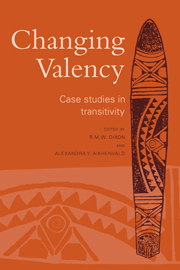Book contents
- Frontmatter
- Contents
- List of contributors
- Preface
- List of abbreviations
- 1 Introduction
- 2 A typology of causatives: form, syntax and meaning
- 3 Valency-changing derivation in Central Alaskan Yup'ik
- 4 Transitivity and valency-changing derivations in Motuna
- 5 Transitivity in Tariana
- 6 Voice and valency in the Athapaskan family
- 7 Valency-changing derivations in K'iche'
- 8 Valency-changing derivations in Dulong/Rawang
- 9 Valency-changing and valency-encoding devices in Amharic
- 10 Complex verb collocations in Ngan'gityemerri: a nonderivational strategy for encoding valency alternations
- 11 Valency-changing derivations in Tsez
- 12 Creek voice: beyond valency
- Index of authors
- Index of languages and language families
- Subject index
2 - A typology of causatives: form, syntax and meaning
Published online by Cambridge University Press: 02 February 2010
- Frontmatter
- Contents
- List of contributors
- Preface
- List of abbreviations
- 1 Introduction
- 2 A typology of causatives: form, syntax and meaning
- 3 Valency-changing derivation in Central Alaskan Yup'ik
- 4 Transitivity and valency-changing derivations in Motuna
- 5 Transitivity in Tariana
- 6 Voice and valency in the Athapaskan family
- 7 Valency-changing derivations in K'iche'
- 8 Valency-changing derivations in Dulong/Rawang
- 9 Valency-changing and valency-encoding devices in Amharic
- 10 Complex verb collocations in Ngan'gityemerri: a nonderivational strategy for encoding valency alternations
- 11 Valency-changing derivations in Tsez
- 12 Creek voice: beyond valency
- Index of authors
- Index of languages and language families
- Subject index
Summary
Introduction
This chapter will survey causative constructions in terms of three parameters: their formal marking, their syntax and their semantics. It will also investigate dependencies between the parameters.
I work in terms of a basic theoretical framework. In any language verbal clauses can be categorized as (i) intransitive, with one core argument, in S function; (ii) transitive, with at least two core arguments, in A and O functions (there are subtypes: simple transitive and ditransitive); and (iii) copula, involving two core arguments, in copula subject and copula complement functions (in some languages the copula complement may be omittable). Within a transitive clause, that core argument whose referent has the potential to initiate or control the activity is linked to A function, and that core argument whose referent may be saliently affected by the activity is linked to O function.
A causative construction is sometimes described as involving ‘two events’. Frawley (1992: 159) talks of ‘a precipitating event’ and ‘a result’, and Shibatani (1976a: 1) of ‘a causing event’ and ‘a caused event’. I prefer a quite different characterization – a causative construction involves the specification of an additional argument, a causer, onto a basic clause. A causer refers to someone or something (which can be an event or state) that initiates or controls the activity. This is the defining property of the syntactic–semantic function A (transitive subject).
That is, if a causative construction is formed by derivation, it will involve the addition of a new argument in A function (the causer).
- Type
- Chapter
- Information
- Changing ValencyCase Studies in Transitivity, pp. 30 - 83Publisher: Cambridge University PressPrint publication year: 2000
- 75
- Cited by

